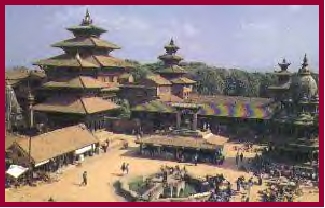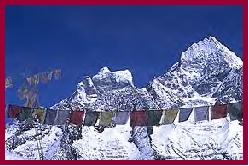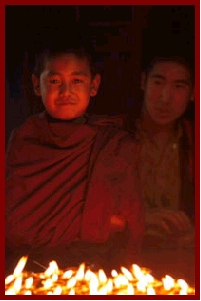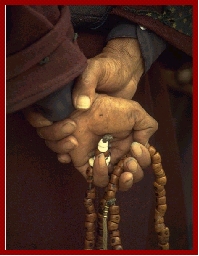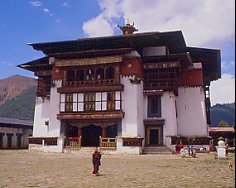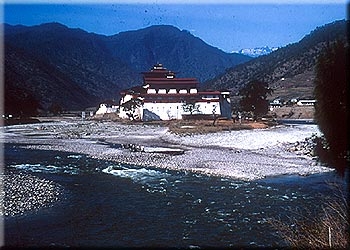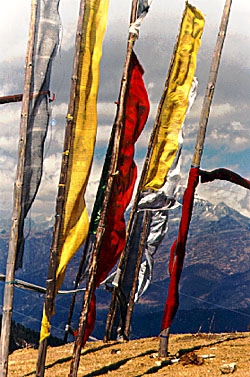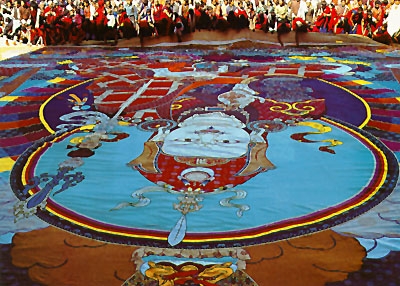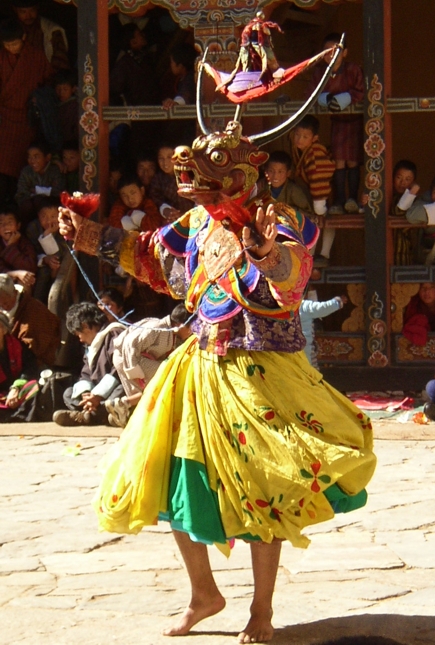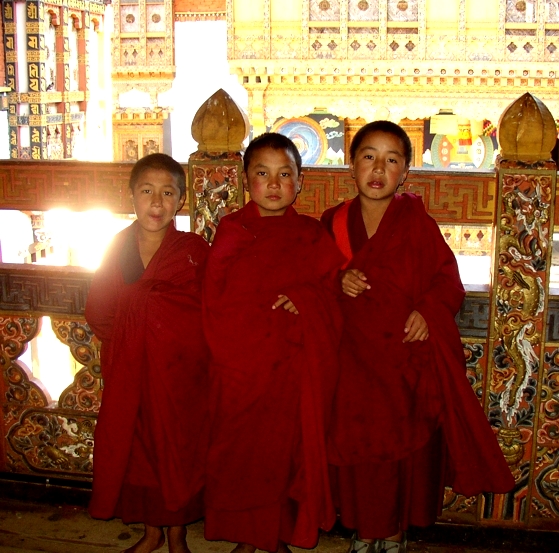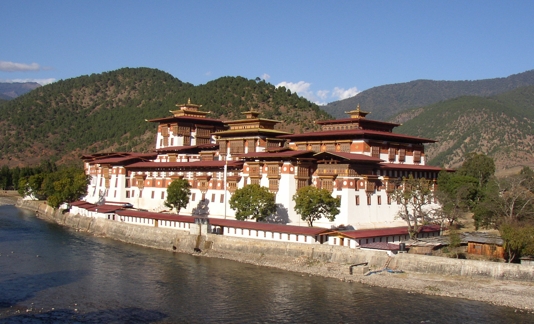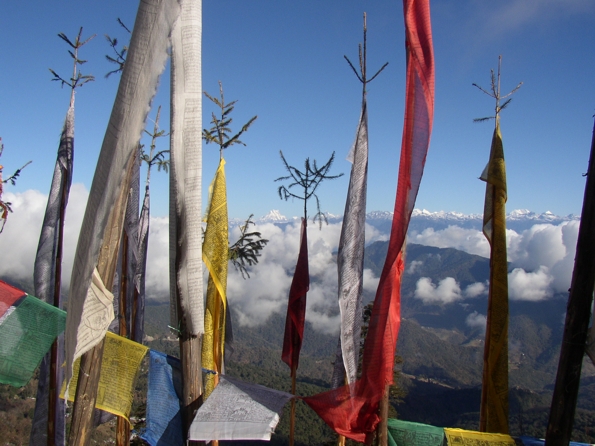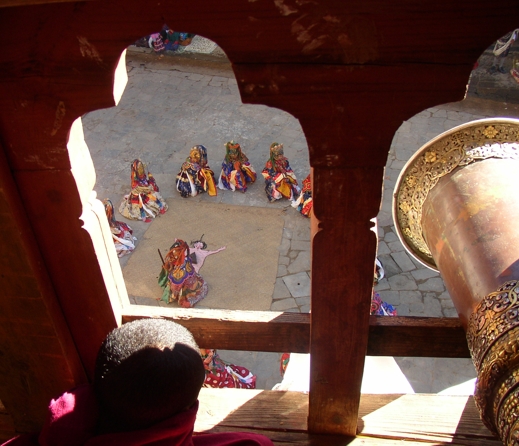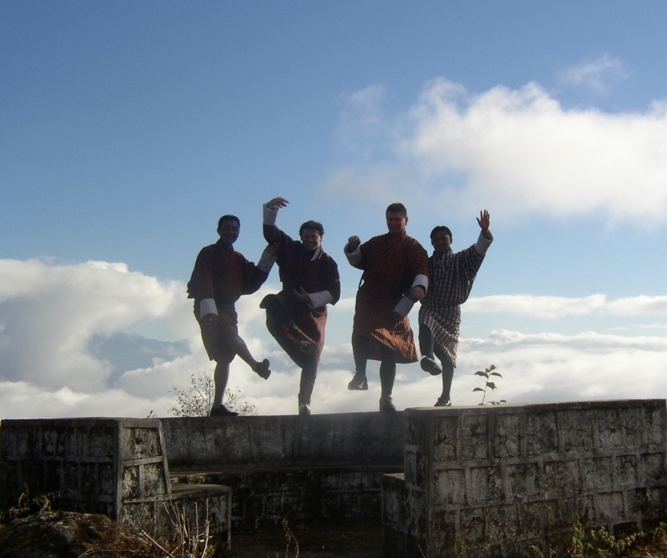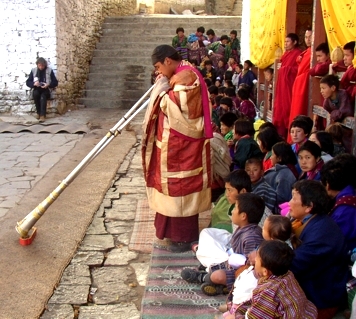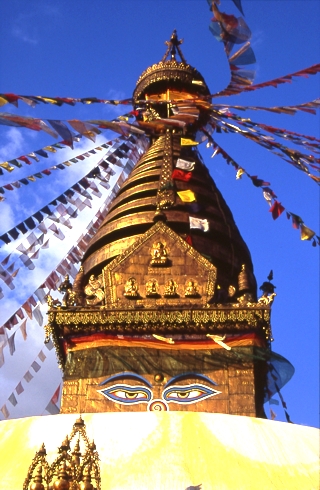BARRON ADVENTURES
BHUTAN
THE LAST HIDDEN HIMALAYAN
KINGDOM
THE REAL SHANGRILA
LAND OF THE THUNDER DRAGON
NIMALUNG AND KURJEY TSECHUS
(MASKED DANCE FESTIVALS) SACRED TEMPLES AND MONASTERIES
ANCIENT CITIES OF THIMPHU, PARO, PUNAKHA, BUMTHANG
TAKTSANG MONESTERY
FOR MORE INFORMATION CLICK THE "CONTACT US" BUTTON OR:
LAND COST:
$4390 10-12 participants
4590 8-10 participants
INCLUDES:
- Hotels, lodges Bhutan
- All meals in Bhutan
- All fees and permits
- Internal transportation
- American guide
- Local guides in Bhutan
DOES NOT INCLUDE:
- Airfare
- Liquor, laundry, tips
- Airport departure tax
- Bangkok overnight

BARRON
ADVENTURES
Adventures, Treks, Expeditions Worldwide
PHONE (562) 708 18800 FAX (562) 592 2099
BOX 100, SUNSET BEACH, CA, USA 90742
INFO@BARRONADVENTURES.COM
The flight to Paro is one of the most spectacular of all the mountain flights, with breath taking views of Mount Everest, Kanchenjunga (the 1st and 3rd highest peaks in the world), and other famous Himalayan peaks, including the sacred Chomolhari and Mount Jichu Drake in Bhutan. Lunch in Paro, and a short drive through spectacular Paro Valley to our hotel, previously a local palace. After lunch, take a short drive to Kyichu Lhakhang, one of the most sacred temples in Bhutan. Bhutanese history says that this temple was one of the 108 temples built in a single day in 659 AD by Tibetan Buddhist King Songtsen Gampo. Pilgrims come from all over the region to worship at this sacred site. Later explore Paro's interesting main street. Overnight Paro hotel. (B,L,D)
DAY 4 PARO
We visit Drugyel Dzong, the ancient victorious fortress of the Drukpas. The Dzong was built in 1649 by Shabdrung Nawang Namgyel to commemorate the victory of Bhutan over Tibetan Invaders in 1644. On a clear day you can see spectacular view of sacred Mt. Chomolhari from the vicinity of the Dzong. The Monastery is perched on a rocky ledge with a sheer drop of nearly 400 mtrs and overlooks the Paro Valley. Visit Kychu Lhakhang, one of the oldest temples in the Kingdom built in 659 AD by Tibetan King Songtsen Gampo. Visit National Museum popularly known to the local Bhutanese as Ta Dzong or Watch Tower, originally built in 1656. The Museum collection includes ancient Bhutanese artifacts, which serve as a wonderful introduction to the rich culture and heritage of the Kingdom. After the museum you hike down to visit the Paro Rinpung Dzong built in 1646, a fine example of Bhutanese architecture - which now house the offices of the district administration and the district monk body. Drive to Bondey and hike past farms and temples to Dzongdrakha Lhakhang. Overnight Paro (B,L,D)
DAY 5 TAKTSANG MONASTERY
After an early breakfast, drive to Satsam Chorten, and on to Taktsang Monastery, perched on a sheer cliffs edge, 2000' above the valley floor. Taktsang, with its 13 holy places, is one of the most venerated pilgrim sites in the Buddhist Himalayan world. The name Taktsang means Tiger's Nest. Legend has it that Guru Padmasambhawa, believed as the second Buddha or Precious Teacher flew to the site of the monastery on the back of tigress and then meditated there in the cave for three months. Taktsang is normally closed to all foreigners, but we have received special permission to enter the monastery. Our trail slowly rises above the valley, taking you through fields and past four large prayer wheels turned by a stream. Continuing across an open meadow, we hike up a section of trail to a ridge where prayer flags rustle in the wind next to a massive prayer wheel. We hike the last section until a few hundred feet from the aerie, and then climb the narrow hewn steps to reach the spectacular aerie and spend most of the day exploring this incredible site. On our descent we have lunch at a unique teahouse overlooking the valley. Then we drive through the dramatic Paro Chhu and Wang Chhu river valleys to Thimphu (2320m). Overnight Thimphu. (B,L,D)
DAY 6 THIMPHU
In Thimphu visit to Textile Museum, the colorful open market, and explore Thimphu city. Visit Memorial Stupa, Arts and Crafts School, National Library, Zilukha Nunnery, Botanical Garden, Traditional Paper Factory, and Thimphu town. After lunch you will visit the Memorial Choeten, a stupa built in 1974 to honor the memory of the third king, His Late Majesty Jigme Dorji Wangchuck. The stupa is one of the most elegant and masterpiece built in the 20th century with its detail religious wall painting and sculptures. Then we visit the 14th century Changangkha Lhakhang, which is also a focus of daily worship for many Thimphu residents. Then you will visit the Dupthop Monastery built by the Dupthop Thangthong Gyalpo, also known as "Iron Bridge Builder" in Bhutan's history. It is now a nunnery and it has more than 70 practicing nuns. Overnight Thimphu. (B,L,D)
DAY 7 THIMPHU - WANGDUE
We begin with the descent into Punakha valley along Bhutan's east-west highway. We take a short hike through rice field to Chimi Lhakhang, the auspicious fertility temple built in 15th Century. Then on to Wangdue. On the way, stop at Dochula pass, which is marked by a large Bhutanese Chorten and Prayer flags, for a hot cup of tea/coffee and lunch, and an opportunity to enjoy the most spectacular view of the high peaks of the eastern Himalayas. Overnight Wangdue (B,L,D)
DAY 8 WANGDUE - TRONGSA
After breakfast visit Wangdue and explore the town. Afternoon drive to Trongsa across Pele La Pass, ascending through farm houses and Chendibji Chorten, built in Nepalese style with gigantic Buddha's eyes painted at the four cardinal points. We pass grazing yaks crossing the road. Crossing the Black Mountains which separate western and central Bhutan, we enter a part of the country which until the l970's was only reached by mule and foot trails. The mountain road passes through deciduous forests and at the second pass, Pele La, ascending through farm houses and Chendibji Chorten, built in Nepalese style with gigantic Buddha's eyes painted at the four cardinal points. We pass grazing yaks crossing the road. The entire area is blanketed by high altitude dwarf bamboo. About five miles from Trongsa, the road winds around a cliff to a viewpoint looking down onto the settlement of Trongsa. The view is one of the most beautiful sights in all Bhutan and one from which you may remember for a long time. Sloping down the contours of a ridge stands the many-leveled Trongsa Dzong (many consider this to be the most beautiful in Bhutan). The Dzong acts as a defensive fortress, and its bright golden yellow roof occupies most of the view from Trongsa. Trongsa is the ancestral home of the Royal Family. Overnight Trongsa (B,L,D)
DAY 9 TRONGSA - BUMTHANG
Drive to four valleys of the Bumthang district, the journey takes about 3 hrs, and is over one of the most scenically beautiful route in Bhutan. Visit yathra-weaving center, wool woven textile. After lunch visit Jakar Dzong built in 17th century, visit Jambay lhakhang built in 659AD by the Tibetan Buddhist king Songtsen Gampo, Tamshing lhakhang built in 1501 by Terton Pema Lingpa. Overnight Bhumthang. (B.L.D)
DAY 10 BUMTHANG - NIMALUNG TSECHU (FESTIVAL)
Very very few westerners have experienced this incredible spectacle. The Tshechu is a festival honoring Guru Padmasambhava, "one who was born from a lotus flower." This Indian saint contributed enormously to the diffusion of Tantric Buddhism in the Himalayan regions of Tibet, Nepal, Bhutan etc. around 800 AD. He is the founder of the Nyingmapa, the "old school" of Lamaism which still has numerous followers. The biography of Guru is highlighted by 12 episodes of the model of the Buddha Shakyamuni's life. The local people in the Trongsa valley celebrate their annual festival after the harvest during the winter. This festival, held in the courtyard of this incredible fortress is one of the most spectacular festivals in Bhutan. During Tsechus, the dances are performed by monks. The Tshechu is a religious festival and by attending it, it is believed one gains merit. It is also a yearly social gathering where people gather from the mountains and valleys, dressed in all their finery, and come together to rejoice. Dance of the Black Hats with Drums (Zshana Nga Cham) The Black Hats wear large brimmed black hat, felt boots, colorful brocade with ornate long dresses and robes. This is a victory dance following the destruction of the evil. The Black Hats beat the drums whose sound resounds throughout the Three Worlds. Peling Ging Sum: Dance of the Three Kings of Ging (Gingsum ) (Driging ) (Ngaging) The Gings wear knee-length greatly ornate skirts and robes. The first part of this dance is performed with sticks and animal masks; the second with swords and fierce masks. This mask dance symbolizes victory of good over evil. The great "Treasure Discoverer" Pemalingpa in Zandopelri, is believed to have seen the dance of the Three Kings of Ging - all emanations of Guru Rimpoche. Evening drive to Wangdi Phodrang. Overnight Bumthang (B,L,D)
DAY 11 BUMTHANG - KURJEY TSECHU
This day we drive to and then hike a half hour to Kurjey for the Kurjey Tsechu. This Tshechu continues with masked dances, temple horns, drums and cymbals, and singing and chanting. The culmination of the Tshechus finalizes with the unfurling of a huge ancient Thangkha (Buddhist Religious Scroll). The gigantic painting is so large that it must be hung from a 3-story building.
DAY 12 BUMTHANG - PUNAKHA
Afternoon depart Trongsa for Punakha. The road to Punakha descends from the pass through the magnificent pine and rhododendron forests and wanders through some of Bhutan's most spectacular countryside. Punakha, situated at an elevation of 1400 m served as the capital of Bhutan until 1955 and still serves as the winter residence of the Je Khenpo (Chief Abbot) and the Central Monk Body. Blessed with temperate climate and fed with the Po Chu (Male) and Mo Chu (Female) rivers, Punakha is one of the most fertile valleys in Bhutan. The climate allows for two crops of rice to be grown a year. And is also good for growing fruits with oranges and bananas in abundance. Lunch at a Bhutanese home. After lunch we will explore the Punakha Dzong built in 1637 by Zhabdrung Ngawang Namgyal to serve as the religious and administrative center of the region. This Dzongs architecture and interior painting and sculpture is one of the world’s greatest Buddhist artworks, with incredibly intricate sculpture, carving and painting. Later drive to Kabesa and take a hike across a long suspension foot bridge through terraces of wheat fields takes you to the Khamsum Yuelley Namgyel Chorten, a monument recently built by Ashi Tshering Yangdon Wangchuk. Overnight Punakha. (B,L,D)
DAY 13 PUNAKHA - PARO
Continue our overland journey to Paro. Stoping for a hike to our lunch in a picturesque village. Afternoon free to wander the bazaar in Paro. Overnight Paro. (B,L,D)
DAY 14 BHUTAN-BANGKOK
Morning transfer to airport for departure to Bangkok. Rest of day to explore Bangkok. (B)
DAY 15 BANGKOK - USA TASHI DELEK!
Depart Bangkok for USA, arrive early morning on the same day.

ITINERARY
DAY 1-2 USA - BANGKOK
Fly from home city, arrive in Bangkok, Thailand . Overnight Bangkok.
DAY 3 BANGKOK - PARO (BHUTAN)
This extension is two days prior to the group arriving in Bhutan. We will be guiding this Kathmandu portion for anyone interested. A night or two in Bangkok on the return trip can be arranged.
DAY 1 BANGKOK-KATHMANDU NEPAL
Kathmandu, Nepal: holy men roam the streets, Buddhist pilgrims spin their sacred prayer wheels, and Hindu yogis meditate in colorful bazaars. Nepal is often said to have "as many gods as the people and as many temples as houses".
Arrive in Kathmandu and transfer to our beautiful hotel. Explore Swayambunath, this fairytale Buddhist pilgrimage site, also known as the Monkey Temple for the thousands of wild monkeys which live in sanctuary there. Spin it's numerous prayer wheels and view the extravagant art displayed. Overnight Kathmandu.
DAY 2 KATHMANDU-PATAN-PASUPATINATH-BODHANATH
Explore Kathmandu, truly one of the most exotic cities in the world, then the ancient city of Patan, lying 5 km southeast of Kathmandu, known as the city of fine arts. The city is full of Hindu temples and Buddhist monuments. The diversity of the medieval culture that allowed both Hinduism and Buddhism to flourish has left a rich legacy of impressive sightseeing, the ancient Hindu pilgrimage site of Pasupatinath with it's many temples-amazing religious sadus and yogis-votive shikharas, shrines and ghats for ritual bathing and cremation. And, the great temple pilgrimage site of Bodhanath, the largest Buddhist stupa in Nepal, dating back 2500 years, and home to the largest number of Tibetans in Nepal. Meet with Buddhist monks and Hindu Sadus. Wander through the incredible bazaars and experience sights that you will see nowhere else on earth. Overnight Kathmandu. (B)
BANGKOK
Day to explore interesting Bangkok, beginning with the Grand Palace complex, which includes the Temple of the Emerald Buddha (Wat Phra Keow) is unquestionably one of the wonders of the world today. Within its enormous grounds is the most exotic Buddhist temple and at the heart of the temple itself is a fabulous Buddha image, carved from one piece of Jade, which is the holiest and most revered of religious objects in Thailand today. Thailand has over 26,000 temples or Wats. We will visit three of the most distinguished ones in Bangkok. Wat Trimitr, the temple of the Golden Buddha. The statue is made from solid Gold weighing 5.5tons. It is a fine example of Sukhothai art and was discovered by chance from a layer of stucco during construction of the temple. And, Wat Po, the temple of the reclining Buddha which is the largest and oldest in Bangkok. Optional afternoon cruise along the Chao Phya-River of Kings passing Wat Arun, the Temple of Dawn.
The hidden kingdom of Bhutan has been isolated from the outside world for centuries. Bordered by Tibet and India, only a few outsiders are permitted into the country each year. Bhutan is an extraordinary place hardly touched by the hands of time. Nestling in the heart of the great Himalaya, it has remained in self-imposed isolation, aloof from the rest of the world. Few westerners have experienced its riches. Known by its people as Druk Yul - The Dragon Kingdom, the environment is pristine, the scenery and architecture awesome, the people hospitable and charming, and the fascinating culture unique in its purity. This trip centers on a very remote Bhutanese Tsechu (festival), a kaleidoscope of whirling dancers in colorful costumes, beautiful singers, mischievous jesters, long temple horns, drums and cymbals, and thousands of locals dressed in their finest clothing and jewelry, which only a handful of outsiders have witnessed. Experience a once in a lifetime opportunity to explore this rich untouched culture, and explore its magnificent Himalayan mountains and valleys. Take a step back in time for a glimpse of traditions and customs disappearing for the rest of the Himalayan world. Bhutan is truly the real Shangri-La. (Scroll down for itinerary)
